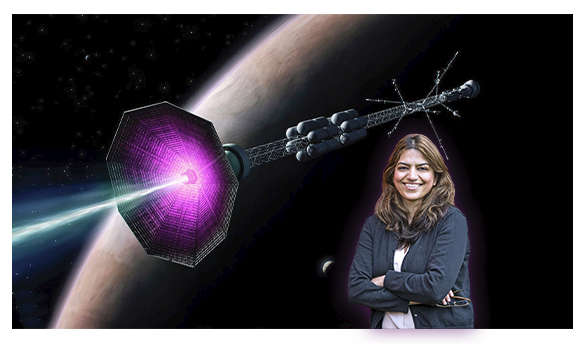Create a free profile to get unlimited access to exclusive videos, sweepstakes, and more!
Physicist designs magnetic thrust engine that could rocket us to the Red Planet

With SpaceX continuing the testing phase for Starship and enthusiasm spreading for an actual crewed flight to Mars, an interesting magnetic thrust rocket concept conceived by physicist Fatima Ebrahimi at the US Department of Energy’s (DOE) Princeton Plasma Physics Laboratory (PPPL) might make the mission much more cost effective.
The feasibility of safe, sustainable propulsion systems that will outperform traditional chemical-based rocket engines on deep space voyages, not only in our own solar system but someday perhaps to a distant galaxy outside the Milky Way, is foremost on astrophysicists' minds.
Ion thrusters, once the standard mode of acceleration for imaginative sci-fi authors and now the preferred positioning engine for NASA scientists and engineers in their satellites, might have greater endurance and are a lot cheaper to operate but generate a minuscule amount of thrust for acceleration purposes. This isn't exactly a viable option for a trip to the Red Planet where hundreds of tons of spacecraft are being moved across the heavens.
Ebrahimi's Princeton team has developed a new concept that involves utilizing the same basic cosmic mechanism that helps shove solar flares outward from our Sun. These violent eruptions are comprised of charged atoms and particles known as plasma, which are imprisoned inside intense magnetic fields. Their findings were published in the online research site, Journal of Plasma Physics.
To harness this dynamic energy into an effective propulsion system, Ebrahimi is targeting a type of interaction called magnetic reconnection, which is where magnetic fields in highly charged plasma environments automatically restructure themselves to converge, separate, and re-converge.
The consequences of this cyclical reaction is an impressive powerhouse of kinetic energy, thermal energy, and particle acceleration. This phenomenon is not limited to stars, but also occurs within our planet's atmosphere and Tokamak fusion reactors, such as PPPL’s National Spherical Torus Experiment.
This innovative thruster produces movement by ejecting both plasma particles and magnetic bubbles known as plasmoids, which increase power to the propulsion.
"Long-distance travel takes months or years because the specific impulse of chemical rocket engines is very low, so the craft takes a while to get up to speed," Ebrahimi explains. "But if we make thrusters based on magnetic reconnection, then we could conceivably complete long-distance missions in a shorter period of time. While other thrusters require heavy gas, made of atoms like xenon, in this concept you can use any type of gas you want."
A magnetic thruster works in ways like modern ion thrusters that are becoming increasingly common on a wide array of probes and spacecraft. These operate by charging a propellant base made up of heavy atoms like xenon, then introducing an electrical field and causing them to accelerate. In Ebrahmi's intriguing concept, magnetic fields are recruited for the acceleration job.
Currently, computer simulations derived from PPPL computers and the National Energy Research Scientific Computing Center at the Lawrence Berkeley National Laboratory in Berkeley, California, indicate that magnetic reconnection thrusters can theoretically manufacture exhaust velocities ten times faster than any electric propulsion systems being used today.
“This work was inspired by past fusion work and this is the first time that plasmoids and reconnection have been proposed for space propulsion,” Ebrahimi added. “The next step is building a prototype!”















